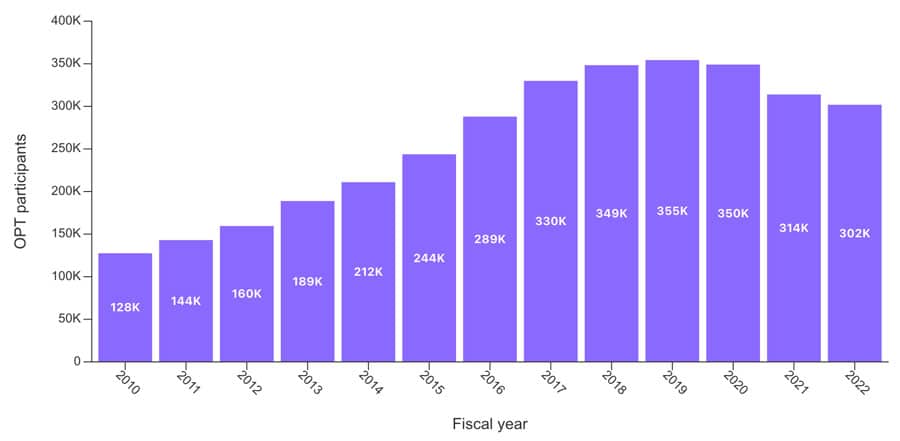US: Study estimates that changes to international student policies could reduce GDP by up to US$481 billion per year
- More than half of all international graduates in the US participate in Optional Practical Training (OPT)
- The programme is heavily used by STEM graduates and even more so by those completing master’s or doctoral degrees
- The US administration has signalled that changes to the programme, possibly even its cancellation, are forthcoming
- A new analysis projects that this could result in a reduction in US GDP of nearly a half trillion dollars per year
The US administration continues to signal its willingness to alter long-established immigration policies affecting international students. For example, it was recently announced that for the H-1B post-study work visa, there would be a US$100,000 application fee for prospective employers. Only later did immigration officials clarify that this would not apply to foreign graduates in the US on an F-1 visa.
That was in itself a significant development, as the H-1B is one of two main pathways for foreign students to stay and work in the United States after graduation. The other is the Optional Practical Training (OPT) programme.
OPT provides foreign graduates with an opportunity to stay and work for up to 12 months (up to 36 for STEM graduates). The programme is heavily used, and it has grown dramatically since 2000.
A new resource, The OPT Observatory, provides a careful analysis of data to illustrate growth in use of the H-1B, along with a number of other key indicators for the programme. It finds, for example, that the number of OPT participants grew from roughly 128,000 in 2010 to just over 300,000 by 2022.
Overall, more than half (56%) of all international graduates in the US from 2010–2022 participated in OPT.

The programme is structurally biased towards STEM graduates and so, not surprisingly, participation is especially high for graduates from STEM fields, and especially for those holding advanced degrees. The OPT Observatory explains: "In 2022, 68% of STEM graduates used OPT compared to only 50% of non-STEM graduates. In the same year, 67% of PhD and 64% of master's graduates participated in OPT. At 76%, the group of graduates with the highest rate of participation in OPT was STEM PhDs."
The analysis adds: "OPT is the single most important pathway for high-skilled immigrants trained at US institutions to stay and work after graduation, and acts as an important bridge to other work visas by allowing international graduates to find employers who will sponsor them to stay in the US."
A recently published paper, co-authored by IFP's Jeremy Neufeld and Amy Nice, echoes the point: "International education is the primary ‘front door’ for US high-skill STEM immigrants to enter the US workforce."
Changes to OPT could be looming
The confusion around the H-1B was the only the latest in a series of dizzying policy announcements and interventions by the federal government with respect to higher education in the United States and international students in particular. That the government has also signalled its willingness to reform or even cancel the OPT programme is therefore a source of real concern for higher education institutions, employers, and foreign students in the US.
Most notably, US Customs and Immigration Services Director Joseph Edlow indicated during his 26 May 2025 Senate confirmation hearing that he intends to review and possibly even rescind the OPT programme.
US lawmakers have subsequently introduced legislation that would cancel or otherwise revise the programme, about which Chris Glass, a professor with the Center for International Higher Education at Boston College, has written very persuasively on Substack.
He concludes: "OPT reform is coming. Major restructuring at minimum, outright elimination possible. When the 'breaking news' alert arrives on your phone, don’t be surprised.
It will happen all of the sudden, just like the 6,000+ SEVIS record revocations, the 3-week 'visa pause,' the proposed elimination of Duration of Status (DOS), and the announcement of a $100K fee for H-1B visas.
The timing is unclear. But some kind of action appears likely. And I expect sometime within the next few months."
Making the link to international recruitment
In September 2025, the Institute for Progress and NAFSA released the findings from a survey of prospective and current international students in the US. The survey was conducted over August and September, and it found that most current students (64%) were intending to the stay in the United States after graduation.
The survey also demonstrates conclusively that any substantive changes to OPT or the H-1B programme could have a massive impact on recruitment.
More than half of respondents (54%) said they would not have come to study in the US had OPT been rescinded. A similar proportion said changes to H-1B would also have discouraged them from coming to the US to study.
Making the link to the innovation economy
In their October paper, Mr Neufeld and Ms Rice, along with co-author Michael Clemons, set out the scale of impact that foreign graduates have on innovation and on the economy in the US.
"International students who remain in the United States after their education are, collectively and disproportionately, a force for economic growth. Immigrants founded 44% of all 'unicorn' billion-dollar startup companies from 1997 to 2019, and immigrants or their children founded 46% of the 'Fortune 500' largest firms in America. Of the immigrants who founded high-potential startups backed by venture capital, 75% came to the United States as international students – not on work visas, not on family visas, not by any other channel."
The paper goes on to model two scenarios, each of which could be considered as reasonably conservative, and especially so in light of the findings from the NAFSA/IFP survey.
- Scenario #1: A one-third reduction in the number of foreign STEM graduates from US universities retained in the US labour market.
- Scenario #2: A 10% reduction in the number of foreign STEM graduates from US universities entering the US labour market.
Under the first scenario, the macroeconomic analysis finds:
"Over a ten-year period, lost annual productivity growth of 0.079 to 0.158% causes GDP at the end of that decade to be 0.79 to 1.57% smaller. This is a percent decline in annual GDP, not a percentage-point decline in annual growth of GDP. That reduction in GDP equates in size to the loss the U.S. economy would suffer from the disappearance of the entire economy of South Carolina (about 1.2 percent of national GDP), Utah (1.0 percent of national GDP), or Wisconsin (1.5 percent of national GDP). If such a loss occurred today, amid the United States’s US$30.4 trillion economy, it would be valued at US$240 to US$481 billion."
The analysis concludes that the more modest reduction anticipated in Scenario #2 (-10%) would nevertheless result in a reduction in GDP "valued at US$72 to US$145 billion."
Leaving aside the prospect of further changes to key programmes such as OPT or H-1B, the authors note that the current uncertainty created by erratic policy movement and process change in the US is likely already having an impact.
"As wait times grow and uncertainty increases, fewer top candidates choose the United States as their preferred destination. Meanwhile, as other countries modernize their immigration systems, they will actively recruit the talent that America is losing. If current policy measures to deter foreign students from coming to the United States succeed, they will leave a large and lasting hole in the high-skill STEM workforce, in the national capacity to innovate, and in the prosperity of future generations."
For additional background, please see:
- "Trump administration’s proposed deal with select US colleges includes a cap on international undergraduate enrolment"
- "China opens up to global STEM talent with new visa class"
- "US administration’s new H-1B policies create uncertainty around post-study work rights"
- "US: Visa status of foreign graduates on OPT under renewed scrutiny"
Most Recent
-
Asia “consolidating as the leading destination region” for international students Read More
-
Kazakhstan sets its sights on being a regional hub for international students Read More
-
US: Study estimates that changes to international student policies could reduce GDP by up to US$481 billion per year Read More
















